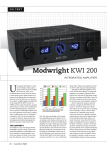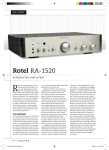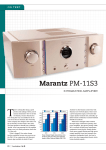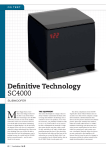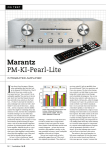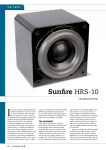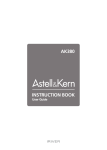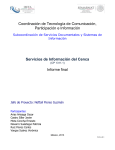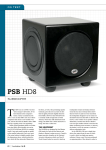Download AVM Inspiration CS 2.2
Transcript
ON TEST AVM Inspiration CS 2.2 Streaming CD/Receiver W hat to call AVM’s Inspiration CS 2.2? Its German manufacturer labels it a ‘compact streaming CD-Receiver’ which, as it happens, is exactly what it is. However this simplistic description somewhat obscures the fact that the Inspiration CS 2.2 also has an inbuilt DAC, so it’s a digital-to-analogue converter as well, plus the ‘receiver’ moniker doesn’t make it entirely obvious that it also functions as a high-end FM radio receiver as well as an internet radio device. Basically, it’s a complete hi-fi system in itself… all you need to do is add a pair of speakers. In times of yore (and those times would be the 60s and 70s for all you millenials) AVM would have dubbed the Inspiration CS2.2 a ‘music centre minus speakers.’ nor any descriptors, of what it does—just the three initials of the manufacturer. In Europe, these three letters would cause anyone in any retail store to pause because in Europe, the AVM company is famous. However, the letters were made famous by a completely different AVM. AVM Computersysteme Vertriebs GmbH is one of Europe’s largest manufacturers of broadband devices and Smart Home products devices, and is best-known for its Fritz! product line of DSL cable, LTE, wireless LAN, and DECT products. However the company that manufactures the AVM Inspiration CS2.2 is ‘Audio Video Manu- One problem AVM might face when marketing the Inspiration CS2.2 is that it’s so small, and looks so plain, that many potential buyers might well underestimate the extent of its capabilities if they were to see it on a shelf in a showroom. As I said, it’s small (340×92×350mm) and of the ten (and note that there are only ten) controls on the front panel, only three of them are labelled… and there’s no model number on the front panel, 90 Australian Newport Test Labs The Equipment Power Output: Single channel driven into 8-ohm and 4-ohm non-inductive loads at 20Hz, 1kHz and 10kHz. [AVM CS2.2] faktur’, and has nothing at all to do with its more famous namesake. Here in Australia, where both AVMs are virtually unknown, the only thing that would cause a casual passer-by to pause and examine the Inspiration CS2.2 more closely is that it’s undeniably beautiful, because the chassis seems so sleek and ‘seamless’. I put that ‘seamless’ in inverted commas because in point of fact there are two visible ‘seams’ on the top of the chassis, but you’ll look in vain for any screws or fixings on the top or sides: all fixing is done from the rear and underside. As you’ve probably already guessed, the reason for the paucity of front panel controls is that AVM intends for the Inspiration CS2.2 to be operated primarily via the remote control that comes standard with every unit. And when you look at AVM’s remote, you can see that it means business because it’s very large, has an LCD screen and is fitted with no fewer than 45 individual controls, many of which serve multiple functions, thanks to the remote also being programmable. Even more importantly, it uses radio-frequencies to converse (and it is a two-way conversation, because the Inspiration CS2.2 also ‘talks’ back to the remote) with the Inspiration CS2.2, which means you can use the remote from almost anywhere in your home: There’s no Newport Test Labs need to have line-of-sight, or even to be in the same room in order to control it. The remote comes with its own dock, which is also capable of re-charging the remote’s battery, but it can also be charged via USB. Although neither the remote nor the dock are particularly unattractive, they do look very ordinary in comparison to the Inspiration CS2.2—so much so that you’d doubt they were made by the same company. It would have been nice if the design of the remote and dock had followed the styling cues of the Inspiration CS2.2 itself. You can also use any iOS or Android device to control the Inspiration CS2.2, because AVM has Apps for both product types. These apps allow you to use your phone or tablet to control many of the Inspiration CS2.2’s functions (volume, source selection, etc) and also enable you to stream content from your device. The Inspiration CS-2.2’s slot-loading CD transport can accommodate standard compact discs, or discs you’ve recorded yourself. Either way, signals from any loaded disc are up-converted to 192kHz/24-bit before analogue conversion. During play, you have access to the usual CD transport functions (fast forward/reverse, skip forward/reverse) plus special functions including programming (up Power Output: Both channels driven into 8-ohm and 4-ohm non-inductive loads at 20Hz, 1kHz and 10kHz. [AVM CS2.2] to 99 tracks), and repeat play (track/disc/programmed selection). There are no A–B repeat or random play options. Track programming is additive (that is, there is no ‘do not play track’ option, so if you want to play only 11 tracks on a 12 track disc, you need to program in the 11 tracks). So although it’s not as full-featured as many stand-alone disc players, you do get all the most-often used functions. If you use the Inspiration CS 2.2 as a DAC, you’ll find that its SPDIF and optical digital inputs will accommodate sampling frequencies of up to 192kHz and both 16-bit and 24-bit words. The USB input is 16-bit only, and has a 48kHz upper sampling rate limit. To achieve higher rates with computer audio it becomes necessary to use the Inspiration Newport Test Labs AVM Inspiration CS 2.2 Streaming CD/Receiver Power Output: Single and both channels driven into 8-ohm and 4-ohm non-inductive loads at 20Hz, 1kHz and 10kHz. [AVM CS2.2] CS2.2’s LAN input, which will then allow you to accommodate FLAC (192/32), WAV (192/32), AIFF (192/32), and ALAC (96/24) files, as well as all MP3, WMA, AAC, and OGG Vorbis file types. And speaking of computer audio, the Inspiration CS 2.2 is compatible with all the Media Servers and NAS drives I’ve heard of (though there may be exceptions, because it seems new ones arrive almost weekly). Germany being the home of the turntable (well, almost…) it wasn’t surprising to find AVM has provided a phono stage that offers both MM and MC inputs. One imagines that AVM has done this to provide support not only for those with existing collections of vinyl, but also for the myriad millenials who have rediscovered the many allures of the LP and have started to purchase them in everincreasing quantities. Of course there are analogue inputs, so you can use your existing disc player (or tape machine, or AM tuner… anything with a line level output). Indeed there are four analogue line level inputs (and two line-level outputs.) There are so many inputs, as a point of fact, that I was pleased to find that you can program the AVM Inspiration CS2.2 to ‘skip’ unused inputs to speed up source selection. And in more good news, you can re-name inputs to suit your system, so that the anonymous ‘IN1’ that comes as the default Line Input 1 descriptor could be renamed ‘BDP’ if you were connecting the audio from a BluRay player to it. It gets better again, because you can also adjust the sensitivity of the various inputs so that no matter what the output voltages of the device you use, you can arrange that the volume level of the music will stay constant as you switch from one music source to another. There’s only the one set of speaker terminals, and so you can’t run a ‘B’ pair of speakers in a second room (which is a pity, because this would have been a great application, thanks to ON TEST the remote) but these terminals are ‘nonstandard’ in that they’re set up for insulated banana plugs, presumably in part because the negative terminal carries a voltage (so never connect it to ground, or to a powered subwoofer without first checking with your dealer that it’s safe to do so. I’ve seen these before on some components built in the United Kingdom, but didn’t know what they were called. According to Google, they’re ‘BFA’ (Built For Audio) terminals. They are very good connectors, because they’re electrically excellent, and completely insulated, so you’ll never get any short-circuits, but the connectors themselves are fairly thin on the ground here in Australia, so if you can’t get speaker cables with BFA fittings, your best alternative is to use speaker cables with banana fittings and use banana to BFA adaptors (made by Russ Andrews). But all this will no doubt already have been sorted out for you by your AVM retailer. AVM Inspiration CS 2.2 Streaming CD/Receiver Brand: AVM Model: Inspiration CS 2.2 Category: Receiver/CD Player RRP: $7,256 (Silver or Black) Warranty: Five Years Distributor: National Audio Group Address: Level 1. 585 Burwood Road Burwood VIC 3122 (03) 9230 2088 [email protected] www. nationalaudiogroup.com.au • Compact & upgradable • Does it all • Super-stylish • Speaker terminals LAB REPORT Readers interested in a full technical appraisal of the performance of the AVM Inspiration CS2.2 Streaming CD/Receiver should continue on and read the LABORATORY REPORT published on page 93. Readers should note that the results mentioned in the report, tabulated in performance charts and/or displayed using graphs and/or photographs should be construed as applying only to the specific sample tested. Lab Report on page 93 avhub.com.au 91 ON TEST AVM Inspiration CS 2.2 Streaming CD/Receiver In Use and Listening Sessions In common with many hi-fi components that connect to the internet, the Inspiration CS2.2 can also be upgraded via the internet (or via a USB stick if you are not connected to the internet). In fact during the two-and-a-half months we had the Inspiration CS2.2 for review, it was upgraded twice, the second time to enable it to be controlled from any portable device running iOS and AVM’s App. We didn’t get a chance to use the App, but it’s been well-reviewed in the Apple store, with one buyer saying (at least according to Google’s garbled translation from German): “The app works clean and stable. In particular, sifting through large music specific libraries from the NAS works just fine. Control of Internet radio, switching on and off of the AVM device, volume control, and streaming from an IOS device works perfectly. The design could be a little prettier, but that’s bitching at a high level.” That praise aside, another user did note that he thought “some features are still missing” while another thought AVM could “have spent more time developing it to a higher level.” It’s certainly no replacement for the remote supplied with the Inspiration CS2.2, as the App offers control over only volume and source selection (plus the ability to access webradio, stream music from your UPnP / DLNA media server, stream music from your smartphone or tablet, and to browse and play your music (stored on NAS, CD, USB etc.), for which purpose it also offers control over playback, whereas the supplied remote offers total system control over everything. I managed all the foregoing operations using exclusively the AVM Inspiration CS 2.2’s own remote (though I did also operate it exclusively from the front panel, to make sure this was possible) and I can attest that everything not only works perfectly, but also seamlessly. The volume level indication on the remote is quite small, and so is the readout of time on the system clock, but neither are really necessary to know… more like frills, really. My only heads-up with the remote is that although the major functions are easy to find and use, there are so many features on the AVM that learning and memorising some of the lesser-used functions and commands could be tricky… but I guess the same would apply to any complex piece of electronics. The remote control’s control over volume is rather coarse, and changes volume very quickly: you can get far more precise control using the volume control on the front panel. It seems this is in part because the volume is software-controlled, so that using the front panel control you’ll find that if you turn it quickly you’ll get a rapid volume level change, but in large steps, whereas if you turn it slowly, you’ll get slow volume level changes in very fine steps. However, don’t get too hung up on this, because once you’ve established your desired volume level, the AVM will remember it. Speaking of the front panel, the AVM is super-easy to use with the front panel controls, and I particularly liked the way the five buttons below the display changed function dynamically depending on what mode I was in, so there was no need to dive though layers of menus. The front panel display isn’t overly large, but is still easy-enough to see from across a room, and the lovely blue-on-black display is very smart. I also liked the ‘long version’ advice the display shows when you’re using the Inspiration CS 2.2. For example, when you’re switching the unit on and off, the display shows: “Starting, please wait” and “Going to standby, please wait” respectively. And when you are switching sources, you get advice such as: “Restoring recent source, please wait.” These are small things, but they really do make it seem like the AVM is intelligent, and is really talking to you personally. (Shades of the 2013 movie ‘Her’ starring Joaquin Phoenix and Scarlett Johansson…if you haven’t seen it, watch it, because it’s a great movie!) I started my listening sessions with CDs, not only because almost all my favourite music is in CD format, but also because it’s the ‘easiest’ to immediately get up and running with the AVM CS2.2. Just post a CD into the front-panel slot and away you go! And away we went indeed, because the AVM Inspiration CS2.2’s performance with CD sources was nothing short of stunning. ‘Smooth, coherent sound with excellent imaging and amazing dynamics’ is what my notes say… and that was only on the first page, after I’d listened to just a single disc. The next tracks I played were some tracks Donovan laid down as demos in 1964, which had been unreleased until Sony released ‘The Definitive Collection’ in 1992. One of the tracks (London Town), shows that in many respects, recording techniques have gone backwards since the 60s, because although you can hear the hissing of the master tape in the background, the clarity and realism of the sound in the foreground is impressive. Why? My guess is because there’s no compression, no dubbing, no equalisation, no editing… the engineer has just set up a microphone and pressed ‘record’. The only thing London Town lacks is imaging, because it’s in mono (as are many of the tracks on The Definitive Collection), but the sound is so clean and realistic that it really doesn’t matter, because despite the tape hiss, it’s as if you’re actually there in the studio, listening to Donovan in 1964. This was a totally uncanny feeling for me, and will be for you, too. From there I went a seemingly strange direction, listening to Move’s album ‘Peter Sculthorpe’ released shortly after his death in August 2014 and subtitled ‘A Retrospective Collection of Some Favourite Sculthorpe Works.’ It features Trio Melbourne, Floyd Williams, Dean Frenkel and many others. Unlike most Move albums, the recording quality is a tad variable, since these tracks were recorded over several decades, with the earliest dating from 1975. The sound on From Kadadu, played by Jonathan Paget on acoustic guitar (a Greg Smallman) is outstanding for its tone and detail, plus the capture of the smallest background noises. I also loved the haunting sound of Rachel Atkinson’s cello on Night Song against the austere piano of Roger Heagney. Isisn Cakmakcioglu’s violin playing is superb on this piece, but I’d love to hear this work scored for two cellos, rather than violin and cello. All these recordings served to show the low background noise of the Inspiration CS 2.2, along with its ability to deliver outstanding imaging. To get an idea of the AVM Inspiration 2.2’s power capabilities, it was up to the Pixies’ Magdalena to prove the AVM 2.2 isn’t short on power: it was able to deliver eardrum-splittingly loud bass and drums, yet the ‘clicks’ on the cymbal were still crisp, sharp and perfectly rendered. Some warmth was exuded from the casing after a few hours of this mis-treatment (there is no heatsinking… the case itself acts to dissipate heat) and the AVM never shut down, even though it was working hard for much longer than it normally would… and in an Australian summer in an un-air-conditioned room with quite a heat load. FM reception is a bit patchy in my street, so I was a little surprised that the AVM Inspiration CS 2.2 was able to pull in a nice strong signal, the result of which was clean FM sound. I momentarily wondered about the omission of AM and DAB radio tuners until I remembered that once you’ve connected the AVM Inspiration CS 2.2 to the internet, you’ll be able listen to any AM or DAB station in equal (or better) quality via their internet feeds, so from AVM’s viewpoint, there’s not a lot of ‘value-add’ by including these (admittedly freeto-air) music sources. I streamed into the AVM from NAS via a network rips of exactly the same CDs I’d put as physical carriers into the front-loading slot, to give me a handle on how differently the AVM handled the data—because this double-up approach allows straight-forward A–B comparisons—and I really could not tell the difference between the two delivery options, so I’d recommend opting for convenience and converting all your CDs to digital files because through the AVM Inspiration CS2.2, they will sound every bit as good. Conclusion The AVM Inspiration CS2.2 will be absolutely perfect for everyone who wants a component that will do everything (well, pretty much everything…) to an extremely high level of performance, but who does not want one of the bulky—and mostly very ugly—‘Made in China’ components that have dominated this particular market sector for so many years. Jutta Dziwnik Highly recommended. LAB REPORT ON PAGE 93 92 Australian AVM Inspiration CS 2.2 Streaming CD/Receiver LAB REPORT CONTINUED FROM PAGE 92 Test Laboratory Results AVM’s specification. It was slightly higher (112-watts) at 10kHz, but fell to 91-watts at 20Hz. This means that if the AVM Inspiration CS2.2’s power output were rated according to Australian Standards, it would attract a specification of 91-watts per channel. The same overall power vs. frequency trend can be seen when the Inspiration CS2.2 was driving low impedance (4Ω) loads, with the unit’s Class-D amplifier delivering 165-watts both channels driven at 1kHz, 175-watts at 10kHz and 144-watts down at 20Hz. As you can see from the dBW columns, the reduction in output at 20Hz is very small: less than 1dB for both the 8Ω and 4Ω results. The CS2.2 amplifier’s frequency response was measured at 3Hz to 31kHz ±0.5dB with Newport Test Labs tested the power output of the AVM Inspiration CS2.2 mostly according to its usual procedure, which involves measuring the power output of the amplifier just prior to the point of hard clipping. It usually does this at three test frequencies: 20Hz, 1kHz and 20kHz. Because the high-frequency extension of most Class-D amplifiers does not extend beyond 50kHz, this technique can’t be used at 20kHz, so the lab instead tested power output at 10kHz, as shown in the tabulated results, and in the bar graphs. As you can see, the power output of the AVM Inspiration CS2.2 at 1kHz when both channels were driven into 8Ω loads was measured at 110-watts continuous, exactly matching AVM Inspiration CS2.2 — Power Output Measurements Channel Load (Ω) 20Hz (watts) 20Hz (dBW) 1kHz (watts) 1kHz (dBW) 10kHz (watts) 10kHz (dBW) 1 8Ω 105 20.2 114 20.5 112 20.5 2 8Ω 91 19.6 110 20.4 112 20.5 1 4Ω 160 22.0 165 22.2 184 22.7 2 4Ω 144 21.6 165 22.2 175 22.4 Note: Figures in the dBW column represent output level in decibels referred to one watt output. AVM Inspiration CS2.2 – Laboratory Test Results Test Frequency Response @ 1 watt o/p Frequency Response @ 1 watt o/p Channel Separation (dB) Channel Balance Interchannel Phase THD+N Measured Result Units/Comment 3Hz – 31kHz –1dB 1.5Hz – 57kHz –3dB 81dB / 78dB / 47dB 0.053 0.06 / 0.04 / 0.71 (20Hz / 1kHz / 20kHz) dB @ 1kHz degrees ( 20Hz / 1kHz / 20kHz) 0.02% / 0.18% @ 1-watt / @ rated output Signal-to-Noise (unwghted/wghted) 77dB* / 84dB* dB referred to 1-watt output Signal-to-Noise (unwghted/wghted) 80dB* / 91dB* dB referred to rated output Output Impedance Damping Factor 0.04Ω @1kHz 200 @1kHz Power Consumption 17.63 / 24.62 Power Consumption 26.71 / 254.09 Mains Voltage Variation during Test 241 – 252 Heatsink Temperature (Degrees C) N/A *Measured using 20kHz brickwall filt. watts (Standby / On) watts at 1-watt / at rated output Minimum – Maximum @ 1-watt and 5-watts output the 3dB downpoints measured as being at 1.5Hz and 57kHz. Balance between the left and right channels was excellent, at 0.053dB, but separation between them was less so—but more than adequate—even though at 20kHz, it dropped to just 47dB. Interchannel phase results were also good: beyond reproach at audio frequencies and swinging less than one degree even up at 20kHz. Overall THD+N at 1 watt was 0.02% into 8Ω loads. Individual distortion levels are shown in Graph 1. You can see the second harmonic dominating at –65dB (0.056%), with the third and fourth harmonics at around –78dB (0.012%) and the fifth and sixth harmonics at around –90dB (0.003%) The harmonic distortion series extends out to 20kHz, with a single non-harmonic distortion component just above 16kHz that’s most likely a sampling artefact. The amplifier was obviously less comfortable driving 4Ω loads (Graph 2) but overall distortion was still less than 0.05%. Distortion at 110-watts per channel into 8Ω is shown in Graph 3. The second and third components are both around –60dB (0.1%), the fourth is at –90dB (0.003%) and the fifth at –70dB (0.031%). Compared to the output at 1 watt there are higher contributions from odd-order components, particularly at high frequencies. Most interestingly, the audioband noise floor is around 10dB higher than it was at 1-watt (having risen from being around 120dB down at 1-watt to 110dB down at rated output. The ‘grass’ on the noise floor on Graph 4 shows the amplifier’s power supply was under considerable stress trying to maintain an output level of 165-watts per channel into both channels for the duration of the test. Overall THD+N at rated output into 8Ω was measured at 0.18% Signal-to-noise ratios were typical of a Class-D amplifier; satisfactorily low. Although the ‘unweighted’ figures are 77dB referred to one watt and 80dB referred to rated output, these figures don’t include any noise above 20kHz, as Newport Test Labs needs to put a 20kHz low pass filter in the measurement avhub.com.au 93 LAB REPORT AVM Inspiration CS 2.2 Streaming CD/Receiver chain to remove the high-frequency switching noise inherent in all Class D designs to avoid overloading the test instrumentation. With both the low-pass and A-weighting filters in-circuit, the S/N figures improved to 84dB and 91dB respectively. Output impedance was very low, at 0.04Ω at 1kHz, leading to a damping factor at this frequency of 200, which is right on specification and also an excellent result. dBFS 0.00 The internal CD player delivered excellent measured performance in almost all areas, though CCIF intermodulation (Graph 5) was a little higher than I am used to seeing. The frequency response of the CD section (Graph 6) was excellent, as you can see. CD channel separation was very good, as was CD balance. Indeed only errant result from all the AVM Inspiration CS2.2 test results that I could see was its level of power consumption in Newport Test Labs standby mode, which Newport Test Labs measured at 17.63-watts. This is not a particularly high figure per se, but AVM says it’s supposed to be less than 1-watt. However, since the standby mode is under the control of software, perhaps our review sample had a glitch that can be corrected by a future software update to bring standby power consumption Steve Holding back below one watt. dBFS 0.00 -20.00 -20.00 -40.00 -40.00 -60.00 -60.00 -80.00 -80.00 -100.00 -100.00 -120.00 -120.00 Newport Test Labs -140.00 -140.00 0.00 Hz 4000.00 8000.00 12000.00 16000.00 0.00 Hz 20000.00 dBFS 0.00 Newport Test Labs 8000.00 12000.00 dBFS 0.00 -20.00 -20.00 -40.00 -40.00 -60.00 -60.00 -80.00 -80.00 -100.00 -100.00 -120.00 -120.00 -140.00 4000.00 16000.00 20000.00 Graph 9: Total harmonic distortion (THD) at 1kHz at an output of 1-watt into a 4-ohm non-inductive load, referenced to 0dB. [AVM Inspiration CS2.2] Graph 8: Total harmonic distortion (THD) at 1kHz at an output of 1-watt into an 8-ohm non-inductive load, referenced to 0dB. [AVM Inspiration CS2.2] Newport Test Labs -140.00 0.00 Hz 4000.00 8000.00 12000.00 16000.00 20000.00 0.00 Hz Graph 10: Total harmonic distortion (THD) at 1kHz at an ouput of 110-watts into an 8-ohm non-inductive load, referenced to 0dB. [AVM Inspiration CS2.2] 4000.00 8000.00 12000.00 16000.00 20000.00 Graph 11: Total harmonic distortion (THD) at 1kHz at rated output (165-watts) into a 4-ohm non-inductive load, referenced to 0dB. [AVM Inspiration CS2.2] dBFS dBFS 0.00 Newport Test Labs Newport Test Labs 0.40 -20.00 -40.00 0.20 -60.00 0.00 -80.00 -0.20 -100.00 -120.00 -0.40 -140.00 0.00 Hz 6000.00 12000.00 18000.00 24000.00 30000.00 Graph 7. CCIF Distortion (Twin-Tone IMD) @ 0dB using 19/20kHz (1:1) ratio. [AVM Inspiration CS2.2] 94 Australian 20 Hz 100.00 Graph 6. Frequency Response. [AVM Inspiration CS2.2] 1000.00 10000.00 FP Ad REVIEWED Sonus faber Olympica III Yes, you can read some of our reviews in full on AVHub.com.au. You can now swipe your way through every page of Australian Hi-Fi on your iPad or Android Loudspeakers Aragon 8008 Power Amplifier Yamaha NS-SW300 Subwoofer B&W P7 Headphones Richter Harlequin V | www.avhub.com.au January/February 2015 tablet, (or computer) using our snazzy Digital Issues. But there’s nothing like the proper print edition, Loudspeakers S INDY AUDIO L AB RENE WS A CL ASSIC just This is an amplifier you landing in your letterbox sealed in shiny cellophane, ready for you to read at your leisure, at full size, in the order we intended, in the bath, if you like. Get every issue of Australian Hi-Fi the way it should be. FP Ad have to own! yeS! PLeaSe Send me a SUBSCRIPTIOn TO aUSTRaLIan hI-FI y Win! Krix Anniversar eakers A$9.95 NZ$10.99 New Subscription or Mr *Further purchase required. 5 Competition ends 30/3/201 Mrs HF JanFeb15_001 Cover 2.indd 1 Miss Neuphonix AE40 Sp 62 for details* Extend Subscription or Gift Subscription See page 19/12/2014 11:20 am Ms Your Name 14 ISSUES (2 YEARS) $109 SAVE OVER $30 7 ISSUES (1 YEAR) $59 SAVE 15% InCLUdeS hOme CInema & hI-FI LIvIng SPeCIaL eaCh yeaR W mymagazIneS.COm.aU Your Address Postcode Daytime Phone ( ) SUBSCRIPTIOnS PO BOx 3355 ST LeOnaRdS nSW 1590 paYMEnt DEtaILS I enclose a cheque/money order for $ E-mail Please provide phone or email in case of delivery issues If a gIft SubScrIptIon Sydney (02) 9901 6111 TOLLFRee 1300 361 146 Mr Mrs Miss Ms payable to Next Media Pty Ltd or Charge my credit card: Mastercard Visa American Express Recipient’s Name Recipient’s Address Daytime Phone ( E-mail ) Name on Card Expiry Date / Cardholder’s Signature Terms and conditions: Price offer available to Australian and NZ residents. Expires 3/5/15. Includes GST. Savings based on total cover price. Overseas Airmail 14 issues A$195 or 7 issues A$99. Australian Hi-Fi subscription comprises of 7 issues PA – 6 regular issues and 1 special issue. This form may be used as a Tax Invoice. nextmedia Pty Ltd ABN 84 128 805 970. Please tick if you do not wish to receive special offers or information from nextmedia or its partners via email mail. Please refer to www.nextmedia.com.au for the full Privacy Notice. 95 avhub.com.au MA/HF Postcode






